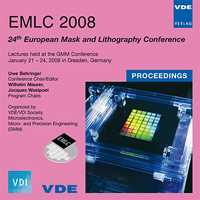Strategies for hybrid techniques of UV lithography and thermal nanoimprint
Conference: EMLC 2008 - 24th European Mask and Lithography Conference
01/21/2008 - 01/24/2008 at Dresden, Germany
Proceedings: EMLC 2008
Pages: 11Language: englishTyp: PDF
Personal VDE Members are entitled to a 10% discount on this title
Authors:
Wissen, M.; Bogdanski, N.; Scheer, H.-C. (Microstructure Engineering, Faculty of Electrical, Information and Media Engineering, University of Wuppertal, Rainer-Gruenter Str. 21, D-42119 Wuppertal, Germany)
Moellenbeck, S.
Abstract:
This paper discusses a hybrid process of thermal nanoimprint and UV lithography, carried out within UV curable SU-8 and mr-L 6000.5, respectively, on the basis of experiments and calculations of the light intensity distribution within the photoresist. For the non-transparent Si stamps with mixed pattern sizes, ranging from approx. 100nm to 150micrometer, the experiments revealed an optimum imprint temperature of 80deg C for SU-8 and 70deg C to 100deg C for mr-L 6000.5. UV stabilization of the imprinted patterns after stamp removal is possible with negligible loss of the patterns when a broadband UV exposure is applied and the post exposure bake is performed as a temperature ramp, starting in the range of the glass transition temperature of the photoresists. UV stabilized patterns of mr-L 6000.5 can be replicated themselves (working-stamp), after applying a conventional anti-adhesive coating. A successful hybrid lithography of thermal nanoimprint lithography and UV lithography depends on the exposure conditions as well as on the layout of the stamp patterns with respect to the photomask pattern. Superimposing the patterns of a photomask is only uncritical for imprinted patterns in the range of the exposure wavelength and larger, where a trench may develop underneath the edges of imprinted patterns of =1micrometer width. This is due to a shadowing effect caused by exposure over topography. A sufficient stabilization of smaller imprinted patterns in the range of 100nm within a hybrid lithography approach is only feasible when the photomask patterns are not in direct vicinity of the pre-patterned photoresist.


